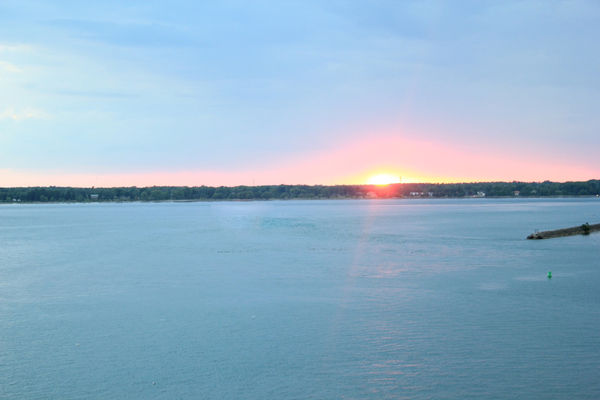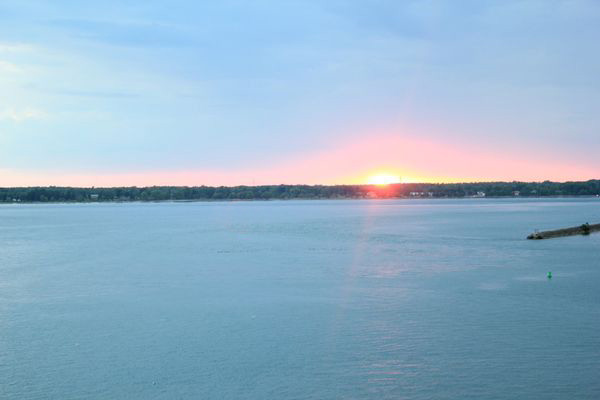Canadian Sunset
Jul 13, 2012 15:04:51 #
John 1813
Loc: Lancaster, NY
ngc1514 wrote:
If you had a filter on the lens, try removing it and see if that eliminates, or decreases, the amount of flare.
Thanks, I was thinking of that.
Jul 13, 2012 15:26:05 #
John 1813 wrote:
Can anyone explain the spot to the left of the sun. This shot was on Manual, but doesn't seem to occur as frequently when I set camera to Auto. Settings were f1/15, f5.6,ISO 400.
Pardon me for stepping in. I too have dealt with this issue a few times. What you are seeing is called lens flare. You lens has many different elements (pieces of glass) inside and the sun is reflecting off of one of them. There is no way of eliminating it unless you change the angle of the shot and sometimes a circular polarizer will help. There is a way in post processing that will eliminate the lens flare. If you have Adobe it's called Spot Healing Brush tool and the Clone Stamp tool. I'm not sure if you have this software or something equivalent to it but that is about all you can do to eliminate the lens flare. I took the liberty of downloading your image and did a quick edit to show you how this looks after it's done. This is a QUICK edit and it is a little sloppy. It can be done alot better than this. I hope this helps you and let me know if I can help with anything else.

Jul 13, 2012 15:37:14 #
John the lens flair is caused by lens refraction. What you see through your viewfinder is what you are going to get in your photo. In your photo where the water meets the land is about half way up the shot. If this had of been one third of the way up the shot I do not think you would have gotten the flair. Aiming the camera more toward the sun would have eliminated the flair also. Some folks shoot to get these flairs. I find them to distract from the photo for the most part. Of course there are always exceptions. I think you need to learn some composition techniques starting with the rule of thirds which is a pain but soon it becomes second nature. The reason you were told to set a smaller aperture, bigger number, and a faster shutter speed was to make you colors pop. These guys get pretty gruff around here sometimes. Especially the old farts. Don't take any offense just be glad you aren't married to them.
Jul 13, 2012 15:45:22 #
docrob
Loc: Durango, Colorado
jimni2001 wrote:
John the lens flair is caused by lens refraction. ... (show quote)
and you would be which old fart in the band shot?
Jul 13, 2012 15:48:36 #
bikinkawboy
Loc: north central Missouri
I do know there's a world of difference in lenses when it comes to flare. I have an old Vivitar lens that is the same focal length as an old Nikon lens of more or less the same age. I've tried it and in situations conducive to flare, it will be very obvious with the Vivitar but practically non-existant in the Nikon. Vivitars were made by well known Japanese lens and camera makers, so it's not like they are el-cheapo junk. Things like flare supression is probably why historically Nikon, Canon, Zeiss and some of the other lenses always cost more than the ordinary brands.
Jul 13, 2012 15:54:39 #
docrob wrote:
and you would be which old fart in the band shot?
and you would be which old fart in the band shot?
I am the hip young guy! :thumbup: It is really easy to pick me out in the photo.
Jul 13, 2012 16:18:25 #
John 1813
Loc: Lancaster, NY
outsider wrote:
quote=John 1813 Can anyone explain the spot to t... (show quote)
Thanks for the input, I appreciate the advice. I do have Elements 10 and am familiar with spot healing and cloning. I was planning on doing that, but I was just inquiring to see if there was a simple way to avoid it in the first place. Thanks again.
Jul 13, 2012 16:26:05 #
John 1813
Loc: Lancaster, NY
jimni2001 wrote:
John the lens flair is caused by lens refraction. ... (show quote)
Thanks. This was just one of many shots I took, most of which were better composed, but this one illustrated the problem more. One more question. Could aiming the camera directly at the sun damage the sensor, much like looking directly at an eclipse would damage your eye?
Jul 13, 2012 17:48:43 #
John 1813 wrote:
Thanks. This was just one of many shots I took, most of which were better composed, but this one illustrated the problem more. One more question. Could aiming the camera directly at the sun damage the sensor, much like looking directly at an eclipse would damage your eye?
Thanks. This was just one of many shots I took, most of which were better composed, but this one illustrated the problem more. One more question. Could aiming the camera directly at the sun damage the sensor, much like looking directly at an eclipse would damage your eye?
John I have seen a lot of speculation on this subject but no definitive answers from any manufactures so I can not give you a yes or no answer. With the sun low in the sky like in your sunset photo or a sunrise I would have to say no and as far as I can glean from other conversations you would have to do a long exposure at high noon to actually damage the sensor. Maybe someone that actually knows the answer could answer. The only thing my manual says is that you can burn out the retina in your eye.
Jul 14, 2012 00:26:10 #
John 1813
Loc: Lancaster, NY
jimni2001 wrote:
quote=John 1813 br br Thanks. This was just on... (show quote)
Well, that wouldn't be good :(
Jul 14, 2012 07:47:30 #
John 1813 wrote:
Can anyone explain the spot to the left of the sun. This shot was on Manual, but doesn't seem to occur as frequently when I set camera to Auto. Settings were f1/15, f5.6,ISO 400.
Sometimes light can bounce around between filters. Some outdoor photographers take them off for shots like these
Jul 14, 2012 08:21:14 #
ngc1514 wrote:
If you had a filter on the lens, try removing it and see if that eliminates, or decreases, the amount of flare.
Some lenses are more prone to flare when shooting into the sun. If you have other lenses in the bag, give them a try and see if it helps.
Some lenses are more prone to flare when shooting into the sun. If you have other lenses in the bag, give them a try and see if it helps.
I agree, flare will result when light reflects off the lense to the back of the filter then back throug the lense.
Jul 14, 2012 08:58:49 #
John 1813 wrote:
One more question. Could aiming the camera directly at the sun damage the sensor, much like looking directly at an eclipse would damage your eye?
Just aiming at the sun? The sensor is not exposed to the sun's light. But I wouldn't want to be looking through the viewfinder while doing the aiming.
If the sun is high in the sky, remember you can set paper on fire with a simple magnifying lens in just a couple of seconds. Semiconductors are not the most heat tolerant pieces of electronics hardware around and I wouldn't be surprised if you blew out a whole bunch of pixels just from the heat alone.
I think I still have an old Mavica Dimage 5 around the house. Perhaps it's time to give the empirical method a try when the sun comes out. We are getting some much needed rain in Atlanta, so I'm not going to wish for sun right now.
I'll let you know what I discover.
Jul 14, 2012 09:59:35 #
Jul 14, 2012 11:09:40 #
jimni2001 wrote:
John the lens flair is caused by lens refraction. ... (show quote)
i just hope you survive long enough to become an old fart but as arrogant as you are i have my doubts. as for my post i simply wanted to help john improve on his sunset photos.
If you want to reply, then register here. Registration is free and your account is created instantly, so you can post right away.







